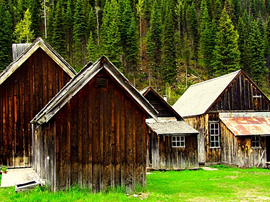Brittany

|
| Morlaix, Christian Duprez, CC BY-SA 4.0, via Wikimedia https://commons.wikimedia.org/wiki/File:Morlaix-cd02.jpg |
In 1862 the town council of Morlaix in Brittany expressed concern that the Chemins de fer de l’Ouest’s proposal for a 62-metre-high viaduct striding through their town might be a tad detrimental to its visual amenity. Nevertheless, the divine right of railways prevailed, since the time when the railway traveller has been able to look down on the weathercock on St-Mélaine’s spire. Of course nowadays le viaduc has become Morlaix’s defining feature.
Prosperous 16th-century linen industry magnates built four-storey, three-jettied town-houses in many Brittany towns. In Morlaix a singular approach emerged: the maison lanterne. In these, the space behind the frontage rooms rises through the full height of the building to a lantern or skylights, giving an impressive hall with an enormous fireplace. A spiral staircase in the corner has a projecting quadrant in timber from which bridges span the space to the rooms at the rear. The balustrades are panelled and, best of all, the supporting newel is a single piece of timber carved from top to tail like a Tlingit totem pole. These houses have the generic local name of pondalez, supposedly from pont and aller.
The area is no stranger to monumental architecture. The Cairn de Barnenez, a very early megalithic monument, is still reckoned to be Europe’s largest mausoleum. Built in two phases in the 5th millennium BCE, it survived intact and little regarded until the 1950s, when somebody started quarrying the stone and public outrage was aroused.
Brittany abounds with megalithic monuments. Most astonishing are the standing stones around Carnac, dating from the 3rd millennium BCE. More than 3,000 stones in groups of up to 1,000 or more stand in east-west ‘alignments’ of 10 to 13 rows, usually with a focus group of stones at their west end. As is often the case with standing stones, there are plenty of hypotheses about their purpose or significance; ritual, familial, societal, funerary, astronomical, mathematical.
The competitive architecture of the pondalez houses was paralleled at community level in the enclos paroissial. In the 16th century, parishes across northern Brittany vied with each other in the construction of new churches with impressive towers and walled churchyards with monumental gateways and other structures. The most eye-catching features are the calvaires, elaborate sculptures of the Golgotha scene with up to 200 figures arranged in tableaux. As most of the carving is in the local granite, these are well preserved. Often there is also an ossuary or funeral chapel, or both. The competition continued into the 17th century, with lavish new interior furnishings with carved decoration. Pulpits, organ lofts, altarpieces, and baptismal font enclosures and canopies are all testaments to the wealth and generosity of their donors.
There is modern lavishness too. The public realm in both urban areas and many villages is of a quality that can usually only be dreamed of in the UK. The central 20 hectares or so of Quimper have been fully pedestrianized, and immaculately paved with beautifully designed granite slabs and sets and street lighting. There are hundreds of municipal planters with a district-wide watering system and a free, circular, electric bus service. Even modest villages have their nicely surfaced central squares and traffic calming, with places of most interest to visitors like Locronan and the charming fortified island town of Concarneau having more widespread enhancement.
The treacherous headland of La Pointe du Raz, once terribly eroded by two centuries of overtourism, has lost its hotels and other detractions. The visitor centre has been resited a kilometre away and the natural flora has been restored. With the rock pipits, wheatears and choughs, and the extraordinary power of the tidal race that gives the place its name, you may keep company with Cyprian Godebski’s monument to Our Lady of the Shipwrecked, who is, in Sylvia Plath’s words, ‘in love with the beautiful formlessness of the sea.’
This article originally appeared as ‘Distinctively monumental’ in the Institute of Historic Building Conservation’s (IHBC’s) Context 178, published in December 2023. It was written by James Caird.
--Institute of Historic Building Conservation
Related articles on Designing Buildings
IHBC NewsBlog
IHBC Context 183 Wellbeing and Heritage published
The issue explores issues at the intersection of heritage and wellbeing.
SAVE celebrates 50 years of campaigning 1975-2025
SAVE Britain’s Heritage has announced events across the country to celebrate bringing new life to remarkable buildings.
IHBC Annual School 2025 - Shrewsbury 12-14 June
Themed Heritage in Context – Value: Plan: Change, join in-person or online.
200th Anniversary Celebration of the Modern Railway Planned
The Stockton & Darlington Railway opened on September 27, 1825.
Competence Framework Launched for Sustainability in the Built Environment
The Construction Industry Council (CIC) and the Edge have jointly published the framework.
Historic England Launches Wellbeing Strategy for Heritage
Whether through visiting, volunteering, learning or creative practice, engaging with heritage can strengthen confidence, resilience, hope and social connections.
National Trust for Canada’s Review of 2024
Great Saves & Worst Losses Highlighted
IHBC's SelfStarter Website Undergoes Refresh
New updates and resources for emerging conservation professionals.
‘Behind the Scenes’ podcast on St. Pauls Cathedral Published
Experience the inside track on one of the world’s best known places of worship and visitor attractions.
National Audit Office (NAO) says Government building maintenance backlog is at least £49 billion
The public spending watchdog will need to consider the best way to manage its assets to bring property condition to a satisfactory level.
















